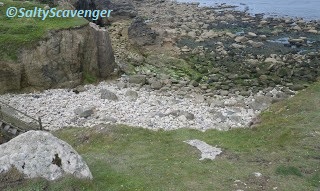The bay experiences a dynamic regime, alternating between periods of erosion (stony) and deposition (sandy).The underlying substrate is boulders and bedrock, however, variable amounts of sand may be deposited on top, sourced from the sand bar situated offshore. The communities encountered reflect the alternation between these regimes.
Please see previous blog posts:
http://thesaltyscavenger.blogspot.co.uk/2015/10/rockpooling-destination-revisit-to.html
http://thesaltyscavenger.blogspot.nl/2015/07/rockpooling-destination-revisit-lands.html
http://thesaltyscavenger.blogspot.nl/2014/05/revisit-lands-end-peninsular-april-2014.html
http://thesaltyscavenger.blogspot.nl/2014/02/rockpooling-destination-lands-end.html
For the past 18 months the shore has been stony and a series of rockpooling visits has documented the slow colonisation and succession of the sea shore communities of the newly available substrate. Now the shore is experiencing increased sand deposition which is influencing the communities previously documented. Notably, increased sand deposition and reduced seaweed cover, particularly of ephemeral green seaweeds, and the infill of many of the sediment filled rockpools.
Below are images showing the change in sediments and habitats observed since April 2015.
Since April, 2015 the amount of sand deposited on the shore has increased covering the underlying boulders that previously supported a 'newly' colonising fauna of ephemeral green and red seaweeds, limpets, periwinkles and sparse barnacles. Now this area of the shore represent a barren mobile sand habitat.
 | ||
This photograph taken in April 2015, shows the previous distribution of sediments in this area of the upper shore.
|
 |
This photograph taken in September 2015 shows the typical Fucoid and ephemeral seaweed communities that covered the bedrock and boulders of the shore which has now mostly covered by sand.
|
Increased sand deposition is also evident on the lower shore where it has filled in rockpools and covered bedrock.
Sand has covered the lower shore bedrock and infilled most of the sediment filled rockpools.
|
 |
This photograph taken in June, 2015 shows the same area of the shore before the sand was deposited. There distribution of the red seaweed and fucoid and rockpools habitats is now far more limited than at the time of this photograph as such rockpooling at either of this times would provide different data sets for the shore and demonstrates the necessity for long term monitoring to ensure accurate characterisation of rocky shores.
|
How will the shore look next time? Well I have been down and I will post what I saw soon!









No comments:
Post a Comment